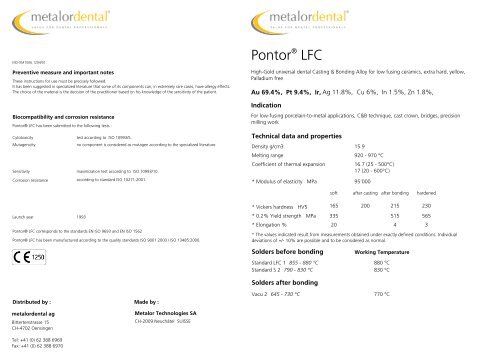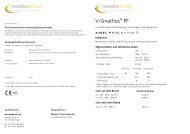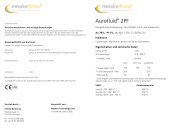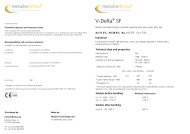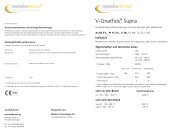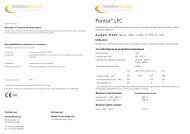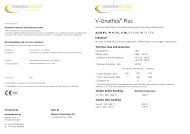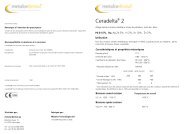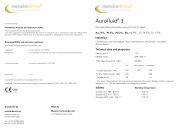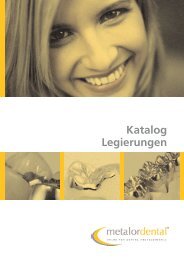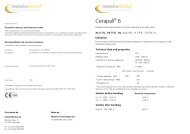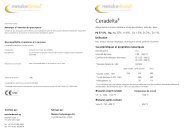Pontor® LFC
Pontor® LFC
Pontor® LFC
Create successful ePaper yourself
Turn your PDF publications into a flip-book with our unique Google optimized e-Paper software.
MD-XM1006.1204/01<br />
Preventive measure and important notes<br />
These instructions for use must be precisely followed.<br />
It has been suggested in specialized literature that some of its components can, in extremely rare cases, have allergy effects.<br />
The choice of the material is the decision of the practitioner based on his knowledge of the sensitivity of the patient.<br />
Biocompatibility and corrosion resistance<br />
<strong>Pontor®</strong> <strong>LFC</strong> has been submitted to the following tests :<br />
Cytotoxicity test according to ISO 10993/5.<br />
Mutagenicity<br />
no component is considered as mutagen according to the specialized literature.<br />
Sensitivity maximization test according to ISO 10993/10.<br />
Corrosion resistance according to standard ISO 10271:2001.<br />
Pontor ® <strong>LFC</strong><br />
High-Gold universal dental Casting & Bonding Alloy for low fusing ceramics, extra hard, yellow,<br />
Palladium free<br />
Au 69.4%, Pt 9.4%, Ir, Ag 11.8%, Cu 6%, In 1.5%, Zn 1.8%,<br />
Indication<br />
For low-fusing porcelain-to-metal applications, C&B technique, cast crown, bridges, precision<br />
milling work<br />
Technical data and properties<br />
Density g/cm3<br />
15.9<br />
Melting range 920 - 970 °C<br />
Coefficient of thermal expansion<br />
16.7 (25 - 500°C)<br />
17 (20 - 600°C)<br />
* Modulus of elasticity MPa 95'000<br />
soft after casting after bonding hardened<br />
Launch year 1993<br />
<strong>Pontor®</strong> <strong>LFC</strong> corresponds to the standards EN ISO 9693 and EN ISO 1562<br />
<strong>Pontor®</strong> <strong>LFC</strong> has been manufactured according to the quality standards ISO 9001:2000 / ISO 13485:2000.<br />
* Vickers hardness HV5<br />
* 0.2% Yield strength MPa<br />
* Elongation %<br />
165 200 215 230<br />
335 515 565<br />
20<br />
4 3<br />
* The values indicated result from measurements obtained under exactly defined conditions. Individual<br />
deviations of +/- 10% are possible and to be considered as normal.<br />
Solders before bonding<br />
Standard <strong>LFC</strong> 1 855 - 880 °C<br />
Standard S 2 790 - 830 °C<br />
Working Temperature<br />
880 °C<br />
830 °C<br />
Solders after bonding<br />
Distributed by :<br />
Made by :<br />
Vacu 2<br />
645 - 730 °C<br />
770 °C<br />
metalordental ag<br />
Bittertenstrasse 15<br />
CH-4702 Oensingen<br />
Metalor Technologies SA<br />
CH-2009 Neuchâtel SUISSE<br />
Tel: +41 (0) 62 388 6969<br />
Fax: +41 (0) 62 388 6970
INSTRUCTIONS FOR USE<br />
Pontor ® <strong>LFC</strong><br />
Waxing up<br />
The ultimate thickness of the cast metal coping should not be less than 0,3 mm.<br />
Therefore: Consideration must be given to this fact at the wax-up stage, long span frameworks require structural<br />
reinforcement to ensure stability and anticipated solder joints should be of adequate surface area to provide sufficient<br />
stability to the frame.<br />
Spruing<br />
Wax sprues of no less than ø 3.5 mm are required. Direct (ø 3.5 mm) and cross bar (ø 5 mm) spruing produce excellent<br />
results. Feeder sprues to heavy pontics should be of at least ø 4 mm. Air vents (ø 1 mm) may be used to advantage. Wax<br />
patterns should be set outside the thermal centre, i.e. near the casting ring wall and about 5 mm from the end. For individual<br />
copings and small bridges (up to three units) , use of the circular sprue provides ideal positioning of the wax patterns and<br />
ensure controlled solidification of the frameworks.<br />
Investing<br />
When using steel casting rings always use refractory liner in order to allow free expansion of the investment. All regular or<br />
phosphate-bonded (e.g. Univest®Plus) investments for precious metal alloys may be used. Follow the procedures<br />
recommended by the manufacturer.<br />
Preheating<br />
Observe manufacturer's recommendations with regard to setting times, temperature levels etc.<br />
On reaching the end temperature a soaking period of 20 to 45 min. is advisable depending on the size of the cylinder.<br />
Preheating temperature : 680°C<br />
Crucibles<br />
Glaze the crucible before first use with a recommended flux (e.g. Borax / Boric acid).<br />
The following crucibles can be used :<br />
Ceramic crucible, Graphite crucible<br />
Re-melting<br />
When melting down thoroughly cleaned casting buttons, add at least 1/3 of new alloy. The used copings have to be clean,<br />
free of investment and flux residue.<br />
Melting<br />
It is important, when using a torch for melting (for inst. Meteor type "O") that the recommended propane (approx. 0.5 bar or<br />
7.25 psi) / oxygen (approx. 1.0 bar or 14.5 psi) mixture and pressure are observed.<br />
Before melting add a pinch of flux to the alloy. Once the alloy has completely melted, continue heating for a further approx.<br />
5 sec. before releasing the casting machine arm.<br />
When melting by induction or resistance heating, the power must be maintained for an additional approx. 5 sec.<br />
Flux : Borax<br />
Graphite crucible : Casting temperature 1120°C<br />
Ceramic crucible : Casting temperature 1160°C<br />
Cooling<br />
Bench cool the casting ring.<br />
Devesting / Cleaning<br />
Clean by blasting with glass beads or pure aluminium oxide (Al2O3) particle size (50 µm to 125 µm) at 1.5 to 2.0 bar (21.7 to<br />
29 psi) pressure.<br />
Pickling<br />
Following casting or soldering, the frame at room temperature may be pickled in hot Desoxid for at least 2 min. - Desoxid I<br />
(75%).<br />
Finishing<br />
Trim the framework first preferably using carbide burs and then fine grinding points at low speed. Blasting is done using pure<br />
aluminium oxide (approx. 110µm).<br />
Recommended grinding points : Cerasiv Brown (5'000 - 10'000 rpm)<br />
Pressure : 1.0 - 2.0 bar<br />
Cleaning<br />
Frameworks must be cleaned preceding oxidation either in boiling water for 10 min. (distilled water is recommended) - in an<br />
ultrasonic unit for 5 min. - or with a steam cleaner.<br />
Gilding (Aurofilm® 2000)<br />
The application of a gilding layer of Aurofilm is possible according to the instructions for use. Aurofilm should be fired in a<br />
ceramic oven.<br />
Firing temperature : 820°C<br />
Oxidation<br />
10 min. without vacuum to 800°C and bench cool.<br />
The framework should have a uniform grey-brown appearance.<br />
After oxidation frames should be cleaned in hot, diluted (10 %) sulphuric acid (H2SO4) or in a hot pickling solution of<br />
Desoxid I for 10 min. Use this solution just for this alloy. Then thoroughly clean frameworks.<br />
Porcelain application<br />
Porcelain or resin applications are subject to the manufacturers instructions. The alloy is compatible with most known<br />
porcelain brands. Consider the CTE of the alloy in conjunction with the cooling recommendation of the porcelain<br />
manufacturer. Paste opaques should be pre-dried for approx. 10 min before firing at manufacturers recommendation.<br />
Pre-drying temperature : 300 - 400°C.<br />
Excellent results have been obtained with the following porcelains (in alphabetical order), with a normal cooling cycle :<br />
Duceragold,<br />
Excellent results have been obtained with the following porcelains (in alphabetical order), with a slow cooling cycle :<br />
Evolution, Response,<br />
Every crown of a bridge must be supported by a supporting stick. An individual firing tray is recommended for long span<br />
bridges.Max. firing temperature :820°C<br />
Soldering / Laser<br />
We recommend using a propane/oxygen torch (Meteor Type "L") for soldering and a flux like Fluxor. During soldering wear<br />
dark goggles for protection.<br />
The design of the soldering block is a compromise between minimising its thermal mass whilst retaining sufficient strength to<br />
avoid its fracturing during soldering. Leave a parallel gap of 0.1-0.2 mm between surfaces to be soldered and sufficient area<br />
to ensure adequate strength of the joint.<br />
Heat treatments<br />
Annealed 800°C / 10 min. - quench in water<br />
Self-hardened by slow (bench-) cooling of the casting ring<br />
Hardened (only after annealing) 450°C / 20 min. - let bench-cool<br />
Polishing<br />
The oxide layer may be removed in Desoxid. Thorough rubberwheeling ensures easy polishing. For best prepolishing results,<br />
soft brushes, felts and cotton wheels are employed using Legabril Diamond diamond-paste. "Whiting chalk" (chalk-powder)<br />
mixed with water on soft brushes or cotton wheels may be used for final high polish.


